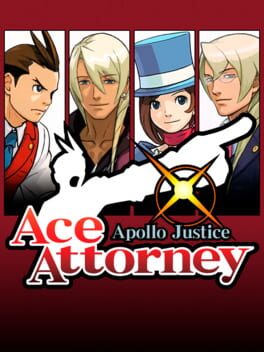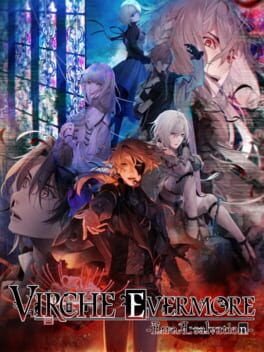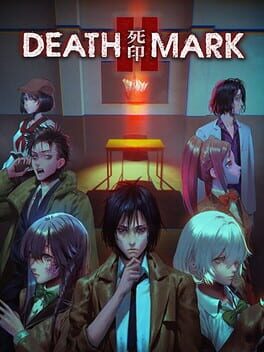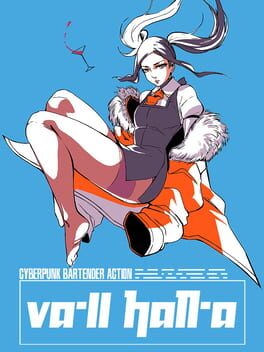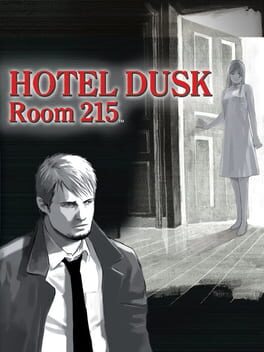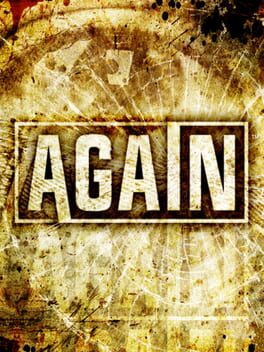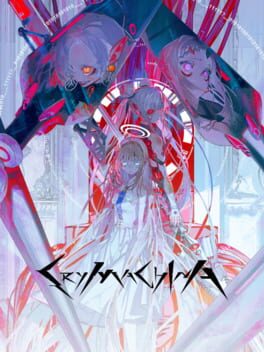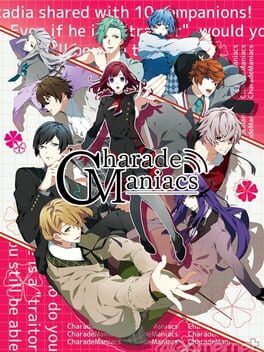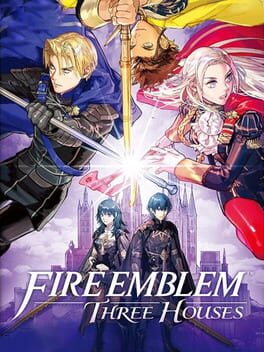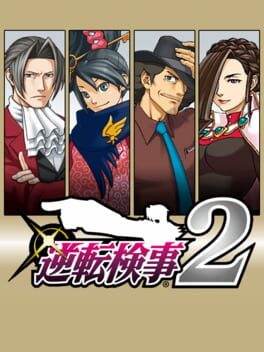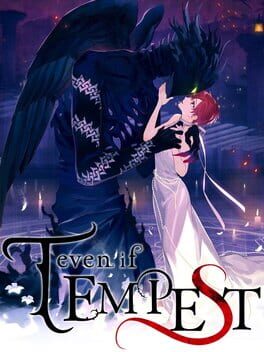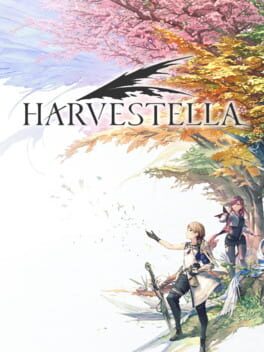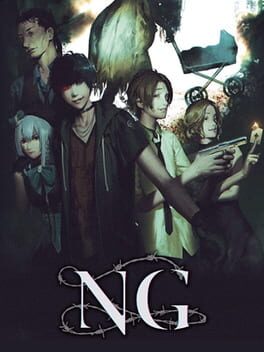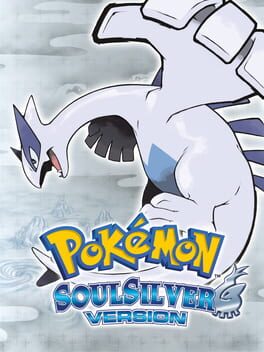almorica
I would say Trials and Tribulations is the most quality story-wise of the series, and the fact that Dual Destinies walks back significant, interesting developments in this game doesn't help Apollo Justice: Ace Attorney -- but there is no beating this cast and the pixel art of this entry to the main line. Completely subjectively, Klavier is the best prosecutor to date, and this set of defendants and their personal backgrounds are the funniest as a crew, only outdone on an individual level by Ron DeLite.
Plus, there is nothing more outlandish than seeing GBA Phoenix's sprites against this level of visual detail. What a choice
Plus, there is nothing more outlandish than seeing GBA Phoenix's sprites against this level of visual detail. What a choice
I have to hand it to Virche for its sheer confidence in itself: it expected me to complete over 50 hours of reading, a full repeat of the game’s lengthy introduction, and all routes before giving me a single good ending. And clearly, I did that. I played this game to the point of viewing all endings, CGs, and text.
My impression was lukewarm at the start — even quite negative at times — but the big and little mysteries and their assorted clues that started piling up kept my attention. It really does give you just about everything you need to guess what the truths are behind the story, and I respect that too. I picked up on a lot of them, but I was very pleasantly surprised that I missed things and eventually got caught off guard as well.
Virche does rely a lot on pseudoscience, however. If you try to predict the story based on real-world facts, good luck. It’s best to just roll your eyes and move on when these things come up, considering it threatened to take me out of the story several times. The world of Virche does whatever the hell it wants with terms and biological realities, and you’re just along for the ride!
While it’s common for otome games, I have to voice my usual problem: where are the girls and women? Why doesn’t the protagonist get a female friend/acquaintance her age? There are so many recurring male characters with sprites, including non-love interests, and only two female characters. The female characters that do exist, sprite or not, get quite the unpleasant treatment by the narrative. While they suffer plenty too, the male characters get far more agency to work with.
The protagonist is one of those suffering, struggling girls, and she may or may not make the experience tough for you. To be blunt, she’s a deeply depressed doormat. Her backstory justifies her willingness to accept a lot of abuse, but it could be unpleasant to watch for certain players. And she gets a lot of abuse from so many characters (including love interests, whether they want to do it or not), from verbal abuse to physical violence to murder.
The romance may also be hit-or-miss. The love interest could be a lot older than the protagonist, or someone she calls her brother, or this or that other questionable spoiler thing. They are heavy romances, to be sure, filled with suffering and very little sweetness or spice, but still a whole lot of devotion to the protagonist. As dark tales (rather than something to dream of), they work.
I have mixed feelings on Virche’s approach to love and how people feel it, but I do give it two thumbs up for including a significant male character with feelings for another male character that is never the target of homophobic abuse. They all have bigger problems, fortunately(?).
As for my experience physically playing the game, there were only scattered typos in the text that didn’t intrude much, and it generally flowed well. I hated the way the screen would go bright white before and after every flashback, though; I probably already remembered what happened in the past and didn’t need to get blinded while being reminded of it. Getting different endings was often more tedious than it needed to be, sometimes seemingly requiring the entire route to be skipped through again to enable a different one to happen.
I appreciated the skip-to-choice button, as slow as it could be sometimes; the easy to access and understand flowchart; the gorgeous CGs; and the clear, definitive “you’re headed for a bad ending” screen effect it did most of the time that was going to happen. It makes the screen all glitchy for a few seconds, which is really difficult to miss.
The music deserves an honorable mention as well. While not something I’d listen to outside of the game, it really works in context.
My recommendation: play Virche Evermore if you want some truly wild and tragic times with beautiful male characters.
My impression was lukewarm at the start — even quite negative at times — but the big and little mysteries and their assorted clues that started piling up kept my attention. It really does give you just about everything you need to guess what the truths are behind the story, and I respect that too. I picked up on a lot of them, but I was very pleasantly surprised that I missed things and eventually got caught off guard as well.
Virche does rely a lot on pseudoscience, however. If you try to predict the story based on real-world facts, good luck. It’s best to just roll your eyes and move on when these things come up, considering it threatened to take me out of the story several times. The world of Virche does whatever the hell it wants with terms and biological realities, and you’re just along for the ride!
While it’s common for otome games, I have to voice my usual problem: where are the girls and women? Why doesn’t the protagonist get a female friend/acquaintance her age? There are so many recurring male characters with sprites, including non-love interests, and only two female characters. The female characters that do exist, sprite or not, get quite the unpleasant treatment by the narrative. While they suffer plenty too, the male characters get far more agency to work with.
The protagonist is one of those suffering, struggling girls, and she may or may not make the experience tough for you. To be blunt, she’s a deeply depressed doormat. Her backstory justifies her willingness to accept a lot of abuse, but it could be unpleasant to watch for certain players. And she gets a lot of abuse from so many characters (including love interests, whether they want to do it or not), from verbal abuse to physical violence to murder.
The romance may also be hit-or-miss. The love interest could be a lot older than the protagonist, or someone she calls her brother, or this or that other questionable spoiler thing. They are heavy romances, to be sure, filled with suffering and very little sweetness or spice, but still a whole lot of devotion to the protagonist. As dark tales (rather than something to dream of), they work.
I have mixed feelings on Virche’s approach to love and how people feel it, but I do give it two thumbs up for including a significant male character with feelings for another male character that is never the target of homophobic abuse. They all have bigger problems, fortunately(?).
As for my experience physically playing the game, there were only scattered typos in the text that didn’t intrude much, and it generally flowed well. I hated the way the screen would go bright white before and after every flashback, though; I probably already remembered what happened in the past and didn’t need to get blinded while being reminded of it. Getting different endings was often more tedious than it needed to be, sometimes seemingly requiring the entire route to be skipped through again to enable a different one to happen.
I appreciated the skip-to-choice button, as slow as it could be sometimes; the easy to access and understand flowchart; the gorgeous CGs; and the clear, definitive “you’re headed for a bad ending” screen effect it did most of the time that was going to happen. It makes the screen all glitchy for a few seconds, which is really difficult to miss.
The music deserves an honorable mention as well. While not something I’d listen to outside of the game, it really works in context.
My recommendation: play Virche Evermore if you want some truly wild and tragic times with beautiful male characters.
Death Mark II dares to ask the question we’ve all been wondering: what if, after improving the series with NG, they made a Spirit Hunter entry where everything got worse?
Amateurish sidescrolling environments and character animations instead of the spooky, heavily detailed visual novel screens of the previous two games?
Live or Die situations but your chances of succeeding, even if you pick the right choice, are randomly generated?
Spirit encounters where your options are so limited it’s easy to pick the right one, but far more boring than the Death Mark and NG encounters because of it?
Sidelining new characters for the sake of using the Mark Bearers as the protagonist’s partners?
Constant back-and-forth exploitation of the misery (for player discomfort) and physical bodies (for player horniness) of teenage girls?
I can’t even say I was ever really scared as a player or absorbed by the intense atmosphere of the game, so everything I loved about Death Mark is out, and everything I found distasteful is in. Although the first Death Mark could get very horny about female bodies in horror situations, somehow they made it feel even worse in this game. It doesn’t help that almost all of these exploited bodies are of high schoolers.
Only one of the spirits in the game is male. His body is only a source of terror, and his backstory is the least explored. The rest are used for as much misery as possible, definitely adequately explaining their grudges, but also going over the top in depicting what someone with the role of “girl” in society can go through and (of course) resolving it with the violent deaths that made them a spirit.
Plus, if there’s a situation where they can make a living or dead female body sexy while they’re suffering, you can bet they’re going for it in this game. More than once the protagonist was about to see something “scary” and I could immediately predict how undressed the victims were going to be. I don’t know — it felt consistently disrespectful of situations they wanted to call terrible, scary violations of human rights. After NG went waaaay down on the horror-horny, I had decent hopes for this game that were crushed early and decisively.
At least I’ll always have the first two games to go back to. As for Death Mark II, I can’t say I’d recommend it to anyone. It sufficiently made me feel gross, but never afraid.
Amateurish sidescrolling environments and character animations instead of the spooky, heavily detailed visual novel screens of the previous two games?
Live or Die situations but your chances of succeeding, even if you pick the right choice, are randomly generated?
Spirit encounters where your options are so limited it’s easy to pick the right one, but far more boring than the Death Mark and NG encounters because of it?
Sidelining new characters for the sake of using the Mark Bearers as the protagonist’s partners?
Constant back-and-forth exploitation of the misery (for player discomfort) and physical bodies (for player horniness) of teenage girls?
I can’t even say I was ever really scared as a player or absorbed by the intense atmosphere of the game, so everything I loved about Death Mark is out, and everything I found distasteful is in. Although the first Death Mark could get very horny about female bodies in horror situations, somehow they made it feel even worse in this game. It doesn’t help that almost all of these exploited bodies are of high schoolers.
Only one of the spirits in the game is male. His body is only a source of terror, and his backstory is the least explored. The rest are used for as much misery as possible, definitely adequately explaining their grudges, but also going over the top in depicting what someone with the role of “girl” in society can go through and (of course) resolving it with the violent deaths that made them a spirit.
Plus, if there’s a situation where they can make a living or dead female body sexy while they’re suffering, you can bet they’re going for it in this game. More than once the protagonist was about to see something “scary” and I could immediately predict how undressed the victims were going to be. I don’t know — it felt consistently disrespectful of situations they wanted to call terrible, scary violations of human rights. After NG went waaaay down on the horror-horny, I had decent hopes for this game that were crushed early and decisively.
At least I’ll always have the first two games to go back to. As for Death Mark II, I can’t say I’d recommend it to anyone. It sufficiently made me feel gross, but never afraid.
2007
Hotel Dusk is a charming older adventure game for the Nintendo DS, featuring a very human cast brought together by some very impressive serendipity. It’s got a funky visual style for character portraits that suit the DS well, but the 3D renditions of the rooms are pretty limited by the hardware choice. The music is fantastic — sometimes truly emotional — but also limited by the DS audio crunchiness. The way of holding the DS sideways and interacting with the stylus really invokes the feeling of carrying a notebook you’re writing in, but the requirement of basically only using the touch screen ever gets tedious. At least you can also advance text by pressing the D-pad or A button.
Despite the limitations, and sometimes because of them, the vibes are immaculately vintage and immersive. Please try it if you’re at all interested in DS-era adventure games/visual novels!
Just, if you play it on anything but the original DS/DS Lite, make sure you’ve picked up a Blacklight item before diving into Chapter 10. Otherwise, you will get stuck in a very unpleasant and potentially lengthy trial-and-error section. I did not do this on a previous 3DS playthrough. A Bad Time Was Had.
Despite the limitations, and sometimes because of them, the vibes are immaculately vintage and immersive. Please try it if you’re at all interested in DS-era adventure games/visual novels!
Just, if you play it on anything but the original DS/DS Lite, make sure you’ve picked up a Blacklight item before diving into Chapter 10. Otherwise, you will get stuck in a very unpleasant and potentially lengthy trial-and-error section. I did not do this on a previous 3DS playthrough. A Bad Time Was Had.
2009
Again is a generic crime story with generic (and sluggish) adventure gameplay, so while it's certainly playable and able to be completed, it's most likely not going to stick with you. It's also not an engaging mystery; it doesn't really give you the tools to solve it as you go, leaving you to wait for someone else (or J's visions) to tell you most of the answers.
Considering it's completely devoid of the interesting character writing and physical location-personality of Cing's other works Another Code and Hotel Dusk, I sincerely hope anyone playing this game plays this after those. Then you'll just know what this one is missing, as opposed to losing faith in Cing's ability to portray them whatsoever.
The transition screens with J's outline walking are about as stylish as it ever gets. So those are cute, at least.
Considering it's completely devoid of the interesting character writing and physical location-personality of Cing's other works Another Code and Hotel Dusk, I sincerely hope anyone playing this game plays this after those. Then you'll just know what this one is missing, as opposed to losing faith in Cing's ability to portray them whatsoever.
The transition screens with J's outline walking are about as stylish as it ever gets. So those are cute, at least.
2023
Crymachina is a game I adore the story and visual presentation of while simultaneously thinking of it as one of my least favorite gameplay experiences. From also playing The Caligula Effect 2, another Aquria-developed RPG, their difficulties don't make any sense. I completed CE2 on the hardest difficulty and found it too easy; I completed Crymachina on Casual and found it irritatingly hard. Random basic enemies should not be able to two-shot you before you can blink when you’re at the appropriate level on any “casual” mode, in my opinion. It should also not be so punishingly trial-and-error in platforming sections (I am never going back to running from the chasing whale).
But everything but the gameplay pushed me to force my way through the ridiculous amount of game overs and late-game grinding to stay at the recommended level. The atmosphere is so heavy and put together phenomenally; environments, music, lore, voice acting, and character portraits all work together to craft something wonderful. It’s a story that reminds me of some other fictions a lot more than Nier Automata, but it’s spoiler territory to explain which and why. Honestly I’d probably love this game a lot if the gameplay was just an exploration of the beautifully desolate Eden, with no annoying battles to speak of.
Although character designs can be casually sexualized and there’s some breast physics going on, play this if you want an intense, human-civilization-pessimistic sci-fi story starring girls shamelessly attracted to other girls.
Also, it runs fine on the Switch, but it does look pretty muddied in handheld.
But everything but the gameplay pushed me to force my way through the ridiculous amount of game overs and late-game grinding to stay at the recommended level. The atmosphere is so heavy and put together phenomenally; environments, music, lore, voice acting, and character portraits all work together to craft something wonderful. It’s a story that reminds me of some other fictions a lot more than Nier Automata, but it’s spoiler territory to explain which and why. Honestly I’d probably love this game a lot if the gameplay was just an exploration of the beautifully desolate Eden, with no annoying battles to speak of.
Although character designs can be casually sexualized and there’s some breast physics going on, play this if you want an intense, human-civilization-pessimistic sci-fi story starring girls shamelessly attracted to other girls.
Also, it runs fine on the Switch, but it does look pretty muddied in handheld.
2018
I completed Charade Maniacs in the span of two weeks and 40-45 hours. A fast-paced, long VN with high production value and an engaging set-up, it was difficult to put down and even more difficult to stop thinking about. The death-game-adjacent mystery is well established and worth pursuing by yourself, avoiding recommended route orders. It drops enough hints along the way to craft your own realistic and off-the-wall theories, adding even more fun if you can bounce those thoughts off someone else playing at the same time you are.
As an otome game, there is romance, and it is a significant part of this game — for better or worse. In a word, the romance is trashy. There are unwanted advances, potential age gaps of 5+ years with the 17-year-old main character, and more hidden away behind spoiler territory. It is not even close to sexually explicit, but you won’t find any sweet, low-stakes young love here. I hope this is what you’ve come here for (or at least what you can tolerate)!
There are a good variety of detailed backgrounds and pretty character portraits, but the CGs leave a little to be desired. They often focus on zoom-ins of the route character and MC as opposed to illustrating complex scenes. They demonstrate nice emotions outside the stiffness of a portrait, at least. The voice acting is top-notch and characterizes each individual well (although the MC is not voiced), and the music is fun and varied, accentuating sweeter scenes and adding tension to darker ones.
The UI is great and stylish, easy to follow and easy to read while adding personality to the game itself. I think the flowchart could be easier to understand, view, and navigate, but it is a relatively low-relevance feature. It’s not the biggest mystery in the game when you do want to use it.
There are some noticeable typos and similar mistakes in the localization, but largely it’s polished and flows well.
And, last but not least, the game features a main-cast nonbinary character consistently referred to with they/them pronouns. The whole trashy thing continues to apply on this romance route as much as the others, but the representation is fun.
So, Charade Maniacs is a good, engaging game I’d recommend to fans of darker otome games and mystery/death game fans who can accept some questionable romance. It’s not the best story and might leave a bad taste in your mouth at times, but it was undoubtedly a cool experience for me.
As an otome game, there is romance, and it is a significant part of this game — for better or worse. In a word, the romance is trashy. There are unwanted advances, potential age gaps of 5+ years with the 17-year-old main character, and more hidden away behind spoiler territory. It is not even close to sexually explicit, but you won’t find any sweet, low-stakes young love here. I hope this is what you’ve come here for (or at least what you can tolerate)!
There are a good variety of detailed backgrounds and pretty character portraits, but the CGs leave a little to be desired. They often focus on zoom-ins of the route character and MC as opposed to illustrating complex scenes. They demonstrate nice emotions outside the stiffness of a portrait, at least. The voice acting is top-notch and characterizes each individual well (although the MC is not voiced), and the music is fun and varied, accentuating sweeter scenes and adding tension to darker ones.
The UI is great and stylish, easy to follow and easy to read while adding personality to the game itself. I think the flowchart could be easier to understand, view, and navigate, but it is a relatively low-relevance feature. It’s not the biggest mystery in the game when you do want to use it.
There are some noticeable typos and similar mistakes in the localization, but largely it’s polished and flows well.
And, last but not least, the game features a main-cast nonbinary character consistently referred to with they/them pronouns. The whole trashy thing continues to apply on this romance route as much as the others, but the representation is fun.
So, Charade Maniacs is a good, engaging game I’d recommend to fans of darker otome games and mystery/death game fans who can accept some questionable romance. It’s not the best story and might leave a bad taste in your mouth at times, but it was undoubtedly a cool experience for me.
After clearing two routes (Black Eagles, Golden Deer) at 290 hours, I feel like I can properly talk about this.
It's a good game. After the rather weak political struggle in Fates, 3H goes hard on crafting an intricate and morally layered conflict that splits into four paths to follow. The story has its problems, but it puts its whole heart into what it's got, making it easier to miss or forgive the flaws. It's also got good visual presentation and endearing characters to recruit.
I think the most likely experience with the four routes is that the first one will feel like your real story, while any further playthroughs will have more ideal armies, thanks to the New Game Plus features. They let you continue a completed save file with various things, like your Renown, and allow you to spend that Renown to automatically raise a character's skill level to S or level their support with Byleth to A. You'll also have a better idea of how to teach your units the second time around, probably. I got through Black Eagles just fine, but my 10 fliers in Golden Deer were another story entirely.
The biggest problem with the four route system is that a significant chunk of every single one of them is exactly the same. If you feel like playing several or all of them, White Clouds may just drive you nuts. After that, though, there was enough story variation between the two I completed that it felt worth it. There were plot revelations in each that didn't come up in the other one.
This is definitely the most dense FE I've played, and that was to its detriment at times. Sometimes it felt really padded out that one chapter's main battle didn't just lead into the next one (especially at the end of Golden Deer!), and even spending the month on Skip doesn't make it go by that quickly. Prepare to either not think much and not recruit many characters, or spend a lot of time deciding how to teach your units and bonding with them around the monastery. Maybe that'll even be more fun to you than the chapter finales?
I liked it a lot, ultimately, when I felt like it wasn't just wasting my time. I would love to know how much of my 290 hours was just waiting on loading screens, though. I'm sure it'd be horrific.
It's a good game. After the rather weak political struggle in Fates, 3H goes hard on crafting an intricate and morally layered conflict that splits into four paths to follow. The story has its problems, but it puts its whole heart into what it's got, making it easier to miss or forgive the flaws. It's also got good visual presentation and endearing characters to recruit.
I think the most likely experience with the four routes is that the first one will feel like your real story, while any further playthroughs will have more ideal armies, thanks to the New Game Plus features. They let you continue a completed save file with various things, like your Renown, and allow you to spend that Renown to automatically raise a character's skill level to S or level their support with Byleth to A. You'll also have a better idea of how to teach your units the second time around, probably. I got through Black Eagles just fine, but my 10 fliers in Golden Deer were another story entirely.
The biggest problem with the four route system is that a significant chunk of every single one of them is exactly the same. If you feel like playing several or all of them, White Clouds may just drive you nuts. After that, though, there was enough story variation between the two I completed that it felt worth it. There were plot revelations in each that didn't come up in the other one.
This is definitely the most dense FE I've played, and that was to its detriment at times. Sometimes it felt really padded out that one chapter's main battle didn't just lead into the next one (especially at the end of Golden Deer!), and even spending the month on Skip doesn't make it go by that quickly. Prepare to either not think much and not recruit many characters, or spend a lot of time deciding how to teach your units and bonding with them around the monastery. Maybe that'll even be more fun to you than the chapter finales?
I liked it a lot, ultimately, when I felt like it wasn't just wasting my time. I would love to know how much of my 290 hours was just waiting on loading screens, though. I'm sure it'd be horrific.
A fairly miserable experience for me, by Ace Attorney standards. None of the new characters are really likeable, the cases try too hard to be perfectly connected and just end up contrived, and Logic Chess becomes the most tedious gimmick in the series as it grows more complex. I wanted to drop it in case 2, and really should have instead of slogging through it for over five months. It did not ever become worth it.
It is still an Ace Attorney Investigations game, though, so the pixel art is fantastic and always a treat to look at.
It is still an Ace Attorney Investigations game, though, so the pixel art is fantastic and always a treat to look at.
2022
I didn't have much faith that the full game would satisfyingly wrap up the immense amount of misery the intro kicks up, but it really, really does. Not a game you really want to play for the romance (especially if you want to see a kiss with the game cover monster, like I know plenty did when it was announced), but a game that commits to the story it's telling and the characters it loops through again and again.
My main problem is that it has more gameplay than your standard VN, but it was wholly unfun to actually play. Definitely play something like GNOSIA instead if you want a engaging Werewolf simulator. It also crashed on me more than a dozen times, generally tripping up in specific spots for some reason.
And it's nice that the best explanation for "why" a specific thing is the way it is is "character's trans". Always positive in my book.
My main problem is that it has more gameplay than your standard VN, but it was wholly unfun to actually play. Definitely play something like GNOSIA instead if you want a engaging Werewolf simulator. It also crashed on me more than a dozen times, generally tripping up in specific spots for some reason.
And it's nice that the best explanation for "why" a specific thing is the way it is is "character's trans". Always positive in my book.
2022
Boy, is it ever nice to be gay AND nonbinary AND treated like that’s no big deal!!
Farming starts off incredibly simple compared to something like Story of Seasons/Harvest Moon or Stardew Valley, but does get slightly more varied as the game progresses.
Easy action RPG elements, slightly more complicated than the farming, but no big challenge. I only died a few times, and never to a story boss.
The way this game explores tragedy reminded me of my favorite parts of Breath of Fire 1+2 and Infinite Undiscovery. The emotions and heart in the main and side quests are powerful, but unsettlingly for such a modern game, nobody breaks down? It is some kind of experience for utterly heart-wrenching circumstances to play out over and over but the people on-screen don't have the good weep they deserve. (There is one instance of particularly sharp emotion that really sold it that time, at least.)
While there is no consistent voice acting or expressions on character models (only their portraits) to bolster the emotional moments, the soundtrack is one of the most poignant I’ve heard in a video game. Some tracks are downright haunting. Could not have asked for better!
Also the food looks unbelievably delicious and the fish look gorgeous. The artist went ham on those. 10/10.
Great, highly-recommended experience overall; no regrets on tolerating “Hellooo little croppieees~” from the fairy over my shoulder on repeat.
Farming starts off incredibly simple compared to something like Story of Seasons/Harvest Moon or Stardew Valley, but does get slightly more varied as the game progresses.
Easy action RPG elements, slightly more complicated than the farming, but no big challenge. I only died a few times, and never to a story boss.
The way this game explores tragedy reminded me of my favorite parts of Breath of Fire 1+2 and Infinite Undiscovery. The emotions and heart in the main and side quests are powerful, but unsettlingly for such a modern game, nobody breaks down? It is some kind of experience for utterly heart-wrenching circumstances to play out over and over but the people on-screen don't have the good weep they deserve. (There is one instance of particularly sharp emotion that really sold it that time, at least.)
While there is no consistent voice acting or expressions on character models (only their portraits) to bolster the emotional moments, the soundtrack is one of the most poignant I’ve heard in a video game. Some tracks are downright haunting. Could not have asked for better!
Also the food looks unbelievably delicious and the fish look gorgeous. The artist went ham on those. 10/10.
Great, highly-recommended experience overall; no regrets on tolerating “Hellooo little croppieees~” from the fairy over my shoulder on repeat.
2019
SwSh are games with a lot of flash and little substance. I played Shield concurrently with a replay of Soulsilver, and it made how little there actually is to do in Galar glaringly obvious. Complete a gym, do a rival battle, run to the next gym, do another rival battle, and repeat almost without rest all the way to the Champion battle. What happened to quaint side locations like Sprout Tower or the game corner or even a department store?
It was nice to look at while I played it, but the story was thin, the characters got little depth (outside of Bede), and the gameplay loop got boring early on and never really mixed it up. I can't really recommend it for more than the visual experience of First Pokémon Entry On The Switch -- and Centiskorch, I guess!
It was nice to look at while I played it, but the story was thin, the characters got little depth (outside of Bede), and the gameplay loop got boring early on and never really mixed it up. I can't really recommend it for more than the visual experience of First Pokémon Entry On The Switch -- and Centiskorch, I guess!
2018
A more streamlined sequel to Death Mark, NG is cozier by virtue of the protagonist having friends and family that get some, or significant, development and screentime. That's both to its benefit (character depth and strength) and detriment (less intense horror atmosphere).
I recommend starting with Death Mark if you just want to be scared, and can tolerate it being horny about [mostly] female bodies in those scary situations. I recommend skipping to NG if you want a horror point-and-click VN with much less of that!
Note: the Switch version is a noticeably slower gameplay experience than it was on my Vita, and is limited to four save files. I also experienced a couple of strange glitches that weren't in my Vita playthroughs. I have to say I prefer the game's performance on Vita.
I recommend starting with Death Mark if you just want to be scared, and can tolerate it being horny about [mostly] female bodies in those scary situations. I recommend skipping to NG if you want a horror point-and-click VN with much less of that!
Note: the Switch version is a noticeably slower gameplay experience than it was on my Vita, and is limited to four save files. I also experienced a couple of strange glitches that weren't in my Vita playthroughs. I have to say I prefer the game's performance on Vita.
Final team: Meganium, Gengar, Golem, Politoed, Raikou, and Lugia.
SoulSilver/HeartGold is the most ideal Pokemon game to date, as far as features go. It’s not perfect: the story and characters are barebones; Pokemon move pools are more limited than they are in more recent gens; there are too many water-type HMs; and the level of wild Pokemon is way too low in late-game, forcing you to do things like grind for a level 45-50 battle on level 32 Pokemon.
But, it’s rich in content otherwise:
- There’s a full second region to explore after you complete the game’s home region
- Your lead Pokemon follows you around on the map and has a huge variety of text reactions based on friendship level and location
- Different Pokemon and activities are available based on time of day and day of the week, as opposed to seasons or unpredictable weather variations
- There are interesting places to visit either in every town or nearby (that aren’t just a gym)
- There are fun NPC interactions and rematches through the in-game phone
- Great art direction
- A varied, solid soundtrack only limited by the DS hardware
- Apricorns are available as a method of collecting more Pokeballs without spending money
If they ever combined the better end of modern graphics, characters, storytelling, and movesets with this level of content (and stability), it really would be perfect.
SoulSilver/HeartGold is the most ideal Pokemon game to date, as far as features go. It’s not perfect: the story and characters are barebones; Pokemon move pools are more limited than they are in more recent gens; there are too many water-type HMs; and the level of wild Pokemon is way too low in late-game, forcing you to do things like grind for a level 45-50 battle on level 32 Pokemon.
But, it’s rich in content otherwise:
- There’s a full second region to explore after you complete the game’s home region
- Your lead Pokemon follows you around on the map and has a huge variety of text reactions based on friendship level and location
- Different Pokemon and activities are available based on time of day and day of the week, as opposed to seasons or unpredictable weather variations
- There are interesting places to visit either in every town or nearby (that aren’t just a gym)
- There are fun NPC interactions and rematches through the in-game phone
- Great art direction
- A varied, solid soundtrack only limited by the DS hardware
- Apricorns are available as a method of collecting more Pokeballs without spending money
If they ever combined the better end of modern graphics, characters, storytelling, and movesets with this level of content (and stability), it really would be perfect.
